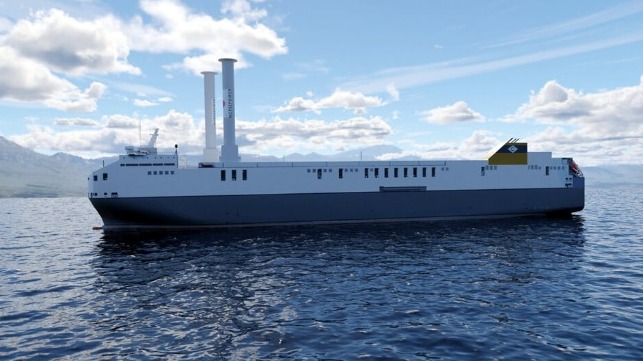Rotor Sails to Be Fitted to Largest Short Sea Ro/Ro

Wind-assisted propulsion is one of the applications that the shipping industry is exploring to help achieve its goals of reducing emissions and improving the operating efficiency of vessels. Among the technologies, rotors that were first proposed a decade ago are enjoying a new resurgence with the latest test planned aboard the largest short sea Ro/Ro vessel currently in operation. The goal is to achieve up to a 10 percent operating improvement for the vessel.
Finland’s Norsepower has signed an agreement with Luxembourg headquartered CLdN, a logistics specialist operating short sea and bulk shipping, for the installation of rotors aboard the company’s Ro/Ro vessel. According to the companies, preparations are currently taking place with the installation anticipated to be completed by December 2022.
Two tilting Rotor Sails will be installed aboard the four-year old Ro/Ro Delphine. Each rotor will measure 35 meters by 5 meters (115 feet by 16.5 feet) producing an estimated seven to 10 percent fuel and emission reduction depending on the route. Currently, the vessel operates between the UK, Ireland, and Europe.
Built in 2018, the Delphine will be one of the newest vessels Norsepower has retrofitted with its technology, which is suited for installation both on existing vessels or newbuilds. The Ro/Ro is a 27,687 dwt vessel measuring 767 feet in length. Registered in Malta it has a capacity of nearly 8,000 lane meters.
“Norsepower’s Rotor Sail installation on the MV Delphine demonstrates how the use of clean technology can modernize and evolve the performance of fleets’ younger vessels to manage emissions and help to increase asset value,” said Tuomas Riski, CEO of Norsepower. “With fuel becoming increasingly expensive, making savings will also have a huge impact on commercial success. Working with CLdN and its ambitious team is an opportunity to demonstrate what our technology has to offer to continue strengthening the environmental and commercial performance of its fleet.”
The Norsepower Rotor Sail is a modernized version of the Flettner rotor, a spinning cylinder that uses the Magnus effect to harness wind power to thrust a ship. Among the modern technologies applied to the century’s old concept, the solution is fully automated and detects whenever the wind is strong enough to deliver fuel and emission savings, at which point the Rotor Sails start automatically. Norsepower also added the ability to till the rotors, with this projected marking the third installation of the tilting Rotor Sail function.

that matters most
Get the latest maritime news delivered to your inbox daily.
The project, which CLdN notes is a pilot project will help determine how the Rotor Sail technology could be rolled out on the current CLdN fleet and new-build vessels, also marks the seventh vessel to be installed with Norsepower’s Rotor Sails.
Among the reference projects the company cites was its first installation in 2014 of two rotors aboard M/V Estraden a North Sea Ro/Ro operated by Bore Ltd. That early project produced a better than six percent reduction in emissions and fuel consumption. Other previous pilot projects included a 2018-2019 test aboard Maersk Tankers vessel and a long-term trial that was completed in 2021 aboard Viking Line’s passenger ferry Viking Grace. Scandlines retrofitted the rotor to one of its ferries and is expanding it to a second vessel, while in 2021 a newly built 325,000 dwt VLOC owned by Pan Ocean Ship Management and chartered by Vale began a trial with five rotors.
